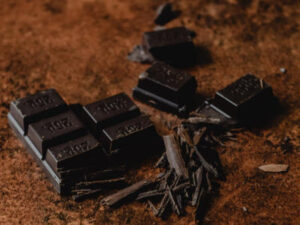Dark vs. Milk and White Chocolate

 Yes, aside from the color of the three main types of chocolate, there are other differences, primarily of the nutritional variety. These differences between the three are derived from two sources, whether or not milk is used as well as the percentage of cocoa solids used in their production (more on cocoa solids later). And while dark chocolate holds more nutritional value than the other two, that does not give us free rein to eat unlimited amounts due to its high caloric content, about 170 calories per ounce.
Yes, aside from the color of the three main types of chocolate, there are other differences, primarily of the nutritional variety. These differences between the three are derived from two sources, whether or not milk is used as well as the percentage of cocoa solids used in their production (more on cocoa solids later). And while dark chocolate holds more nutritional value than the other two, that does not give us free rein to eat unlimited amounts due to its high caloric content, about 170 calories per ounce.
Let’s deal with the less complicated “milk” issue first. The best dark chocolate contains no milk while the Food and Drug Administration sets milk percentage requirements for chocolate to be considered either white or milk. White chocolate must contain at least 14% milk while milk chocolate must contain at least 12% of its namesake. Many brands  of milk and white chocolate go above the FDA’s minimum milk requirement and all three types usually contain an emulsifier or binder, usually soy lecithin.
of milk and white chocolate go above the FDA’s minimum milk requirement and all three types usually contain an emulsifier or binder, usually soy lecithin.
Now, on to cocoa solids, chocolate liquor, and cocoa butter (no, not the stuff you rub on your skin) and the role they play in whether chocolate is considered dark, white, or milk. All chocolate begins as cacao pods which contain 40-50 cocoa beans. The beans are removed from the pod, fermented, dried and roasted.
The meat or nubs are then removed from the shells (or skin) and ground into a powder or paste which is then melted into what is called chocolate liquor (which sounds like an awesome alcoholic beverage, but, unfortunately, is not). Fatty cocoa butter is then usually separated from the liquor. What remains after the cocoa butter has been removed is known as cocoa solids.
Cocoa butter is the primary ingredient in white chocolate which, when combined with milk, gives white chocolate its soft, silky smooth texture. Dark chocolate, on the other hand, uses cocoa solids as its primary ingredient and it is this that gives dark chocolate its superior nutritional value.
 Typically, dark chocolate is made up of only four ingredients, cocoa solids, cocoa butter, sugar and an emulsifier. It is with cocoa solids we are primarily concerned. Cocoa solids, and thus, dark chocolate, are a great source of iron, magnesium, copper, manganese, potassium, phosphorus, zinc and selenium which is great, but what’s greater is the fact that it’s also a great source of antioxidants, such as flavanols.
Typically, dark chocolate is made up of only four ingredients, cocoa solids, cocoa butter, sugar and an emulsifier. It is with cocoa solids we are primarily concerned. Cocoa solids, and thus, dark chocolate, are a great source of iron, magnesium, copper, manganese, potassium, phosphorus, zinc and selenium which is great, but what’s greater is the fact that it’s also a great source of antioxidants, such as flavanols.
In various studies, these antioxidants have been shown to improve blood flow, lower blood pressure, increase HDL (good) cholesterol levels, guard against cardiovascular disease and reduce risks associated with insulin resistance. Since white chocolate has no cocoa solids, it offers none of these health benefits while milk chocolate offers them in limited amounts due to its limited cocoa solids content. One last side note, dark chocolate also contains a fair amount of caffeine, usually 50-70 milligrams or about half the amount contained in an eight-ounce cup of coffee.
So, aside from eating raw cocoa beans, which are extremely bitter, dark chocolate is your best source for the nutritional benefits of the beans. Thus, when you purchase your dark chocolate look for a cocoa content of 70-85% to derive as many health benefits as possible. However, just be aware that the higher the cocoa solids content, the more bitter the flavor.
One way to mitigate that bitter flavor is to melt the dark chocolate down and drizzle it over some oatmeal, yogurt or fresh fruit…think strawberries dipped in chocolate. Just remember, don’t over-indulge as all chocolate, due to its high sugar content, is chock full of calories. Thus, ends your lesson on the nutritional differences between dark, milk and white chocolate…now you know.
You must be logged in to post a comment.